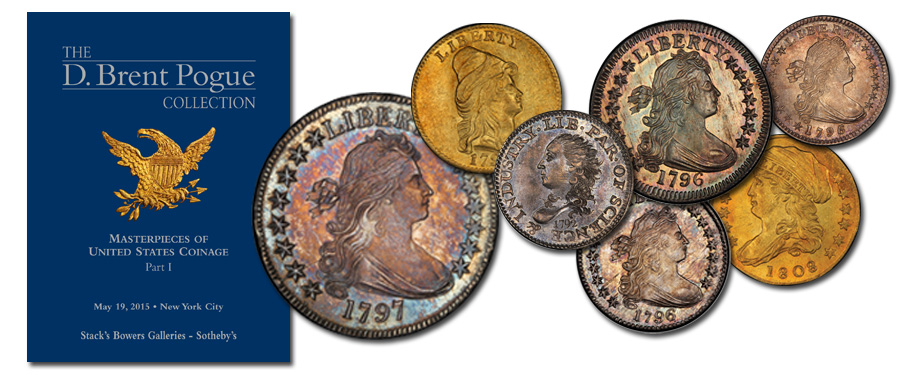
On behalf of Stack’s Bowers Galleries and Sotheby’s I welcome you to our auction program of the D. Brent Pogue Collection of early United States coins. You are a witness to the most valuable collection of United States coins ever sold, formed over the decades from the 1970s to the present. The collection is composed of over 650 copper, silver, and gold coins, and will be presented in a series of auction sales at Sotheby’s headquarters in New York City beginning on May 19, 2015. Each will be a world-class event. You are invited to participate as a bidder and possible buyer, or as an observer. Either way you will have a rendezvous with numismatic history.
Brent Pogue began the careful study of early American coins as a teenager. Soon after, Mack and Brent were familiar faces in auction galleries whenever the most significant or finest known examples were crossing the block.
Emphasis was placed on the early, formative years of the Mint, beginning with 1792 and continuing into the late 1830s. This was the era of hand craftsmanship of dies, of striking the coins on presses powered by two men tugging on a lever arm, and of ever-changing political and economic challenges. This was before the age of steam-powered presses and the mechanical repetition of dies. Each coin has its own characteristics; no two are alike. To these, some selected later series of interest were added to the collection—such as Gold Rush issues and a set of $3 gold coins.
In the early Federal era, relatively few people collected coins. It was not until June 1838 that the Mint Cabinet was established (forming the basis of what is now the National Numismatic Collection in the Smithsonian Institution). Accordingly, the survival of high-grade coins was a matter of chance. Many of the Pogue Collection coins are condition rarities—available in lower grades, but exceedingly rare at the Choice and Gem Mint State levels.
The Pogue Collection is built on a foundation provided by those who have gone before—great collectors from the mid-19th century to the modern era who formed high-quality cabinets. Nearly all of the Pogue coins have provenances tracing their ancestry to earlier numismatists. Examples:
The Garrett Collection was formed by T. Harrison Garrett and his sons from the 1860s to the 1930s and in 1942 was passed to The Johns Hopkins University. This remarkable cabinet was consigned to us and sold from 1979 to 1981 when we worked with Hopkins curator Susan Tripp and her husband David (who is participating in the present sale on behalf of Sotheby’s). Brent and Mack were on hand to study and preview that landmark auction.
When the Louis E. Eliasberg Collection—the only cabinet to have one of each and every date and mintmark of United States coin from the 1793 half cent to the 1933 double eagle— was auctioned by us in a series of three sales from 1982 to 1997, Brent and Mack previewed and carefully studied the coins and were among the most active and successful bidders. From the Eliasberg sales they acquired the only 1822 $5 gold half eagle and the only 1854-S half eagle in private hands. As the only auction sales of an 1822 half eagle in the 20th century were in 1906 and 1982—the Pogue coin—generations of numismatists were born and died without having had the opportunity to own one!
Harry W. Bass, Jr., a fine friend and numismatic connoisseur par excellence, specialized in gold coins and formed one of the finest collections ever, beginning in 1966 and continuing to his passing. Mack and Brent Pogue were front row center among the buyers in our several sales of this remarkable cabinet. Over a long period of years Stack’s in New York City conducted many “name” collections laden with treasures. Again, the Pogues were on hand to capture coins of exceptional quality and value. Connoisseurship was the guiding precept.
Year after year, sale after sale, the Pogues carefully bought the finest of the fine, the rarest of the rare. The result is the collection we now offer in a series of sales, comprising over 650 coins totally. This series of events will forever echo in the halls of numismatics.
The present sale, the first in the series, includes silver half dimes, dimes, quarters, and half dollars, and gold quarter eagles. Coin for coin, no other collection ever formed—not even the Eliasberg Collection or the National Numismatic Collection in the Smithsonian Institution—can compare or even come close to the quality of the D. Brent Pogue Collection. The term once in a lifetime opportunity has never been more appropriate than now.
Welcome to our first sale. You will be part of numismatic history as it is made.
Q. David Bowers
Founders, Stack’s Bowers Galleries





